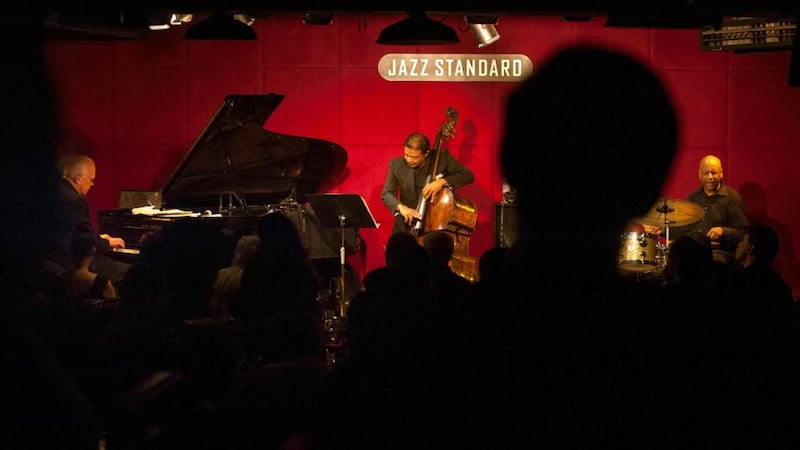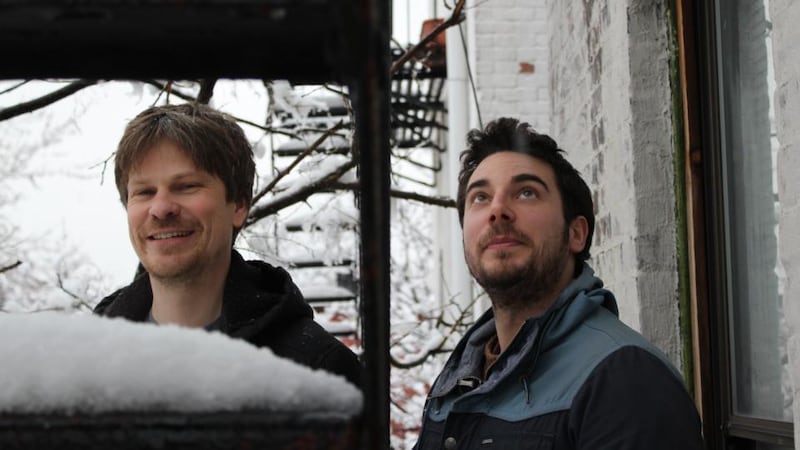New York, New York. Frank Sinatra wasn't the first or the last jazz musician to want to be a part of it. Jazz, that most American of art forms, may have been born on the streets of New Orleans, but it came of age in the basement clubs of Manhattan, and since the 1920s jazz musicians have been converging on the Big Apple to test themselves against the best. If they can make it there . . .
Jazz thrives in most major cities. Even Dublin has a critical mass of improvising musicians. But New York still has a vibe like nowhere else, and so, every year, a new crop of young musicians from around the world touch down to get with the scene here.
Darren Beckett, the Belfast-born drummer, vividly remembers his first night in the city. "I hadn't a clue. I walked out of the airport and took a cab straight to Times Square. I must have seemed like this weird homeless little Irish person with these two huge suitcases. It was scary."


But he soon found his New York feet, sitting in on jam sessions at Smalls Jazz Club, on 10th Street. “You could hang out there in those days,” says Beckett, who now tours the world with the singer Madeleine Peyroux, as well as writing and performing with Brandon Flowers, the Killers frontman.
“I would even sleep there and then go straight to school the next morning. People would hear me play and take my number. It was intense. You’d be playing the jam session and Wynton Marsalis would get up on stage.”
Justin Carroll couldn't have had a more different introduction to the city. As a member of Van Morrison's touring band in the 1990s, the keyboardist's first gig was at Madison Square Garden.
“It was mad. I was staying in a five-star hotel in Manhattan, and I rang Darren Beckett to come and hang out. Then I realised that at that time Darren didn’t even have the money to get a train downtown, let alone come and hang out in the clubs.”
Carroll was soon returning regularly under his own steam, and six years ago he made the move permanent. But his touring commitments with Glen Hansard, as well as his own jazz projects, bring him back to Ireland all the time, and he says he sees his friends at home more now than he did when he lived in Dublin.
Carroll shares an instrument-cluttered apartment in Brooklyn with Matt Jacobson, a drummer and composer who recently arrived from Dublin. The bustling borough across the East River has become the new hub for jazz in New York, as rising rents have put an apartment in Manhattan beyond the reach of most musicians.
Jacobson, who is here thanks to a Fulbright scholarship, is typical of the new breed of wandering jazz musicians who will stay here for a while but probably return to their own scenes eventually. “I came because I felt a connection with something that’s happening here in Brooklyn. You can hear stuff here that you just don’t hear in Dublin,” he says.
One of the more persistent myths is that New York is a jungle where musicians will cut each other's throats to get a gig. But these Irish musicians have had the opposite experience. Guitarist David O'Rourke is evangelical about the city and its musicians. He arrived more than 20 years ago with a few phone numbers given to him by his mentor, the guitarist Louis Stewart, and found that the city's jazz musicians couldn't have been more welcoming.
"American musicians laugh when I tell them this now," says O'Rourke when we meet at the Jazz Standard, in midtown Manhattan, where he heads the Discovery education strand. "We'd heard so much negativity about crime in New York, I was expecting it to be like Kojak ."
But after a few phone calls O’Rourke hooked up with the former Benny Goodman guitarist Bucky Pizzarelli – and soon found himself ushered into New York’s jazz community.
"In my first week I hung out with Les Paul, and the same night I met Woody Shaw at the Village Vanguard. I went up after the show and said, 'Hello, Mr Shaw. I'm a guitarist from Ireland,' and the guy just gave me a huge embrace and his phone number. And I was like, 'Jaysus, I thought it was supposed to be really unfriendly here, and in one day I've been in Les Paul's house and met Woody Shaw.' "
The guitarist and composer Simon Jermyn agrees that musicians here can be warmly welcoming, but he says the city itself can be stressful. Based in Brooklyn for the past six years, Jermyn works with some of New York's leading contemporary musicians, including the drummer Jim Black. But on the night we meet, he's playing with his own trio in the back room of a Brooklyn restaurant to an audience of 10 people. The finances can be challenging, he admits, and to make it work a musician has to do a lot of different things. So what's a typical day like?
“You get up in the morning and practise for a couple of hours, and maybe do a rehearsal. Then you teach for a few hours. Then you go and play a gig somewhere, and then you realise that you’ve just done a 12-hour day and you’ve been on eight or nine crammed subway trains. You’re just so in the middle of it that you’re almost unaware of it until afterwards.”
“You really have to tour to make a living here as a musician,” says Beckett, home briefly between a tour to the Far East and a recording session in Las Vegas. “You can’t do $75 gigs six nights a week and pay rent here. It’s impossible.”
Seth Abramson, artistic director at the Jazz Standard, is frank about the challenges. "It's very difficult to make a living performing jazz full time, and there are very few who do so. Most make a living through some combination of teaching and performance." But he agrees that New York musicians are more than willing to help new arrivals. "Most jazz musicians have been there at some point themselves. It's a fraternity in that sense."
There may be thriving scenes elsewhere, particularly in continental Europe, but all agree that you’ll still find the best in New York. “Anyone who is here is generally really good at something,” says Carroll. “It’s sort of why they’re here. It makes you more aware of what’s out there. You really home in on a very particular craft.”
Simon Jermyn and his wife Annika Jermyn, a graphic designer, haven’t made definite plans yet, but he reckons they’re in New York for the long haul. “I do miss family and friends, and decent Guinness . . . and battered sausages,” he says.
“But I definitely see it as a long-term thing. Sure, it can be tough, but Annika calls it ‘learning to be comfortable with being uncomfortable’.”
For Jacobson, a founder of the Dublin indie label Diatribe, New York is just another stop along the way, and both he and Carroll are quick to stress the nomadic existence of most professional musicians nowadays. “It will be interesting being back in Ireland after having spent time here,” says Jacobson. “In my head I’m very aware of it. I have been thinking of things that happen here that I can try and instigate in Ireland.”
For older musicians, with roots and families here, New York is home. O’Rourke misses Ireland, but New York has been good to him, and he says he’s always ready to pay forward the favours that have been done for him.
"Before I came here my mother had a conversation with Bucky Pizzarelli. She said she'd heard that musicians were a dime a dozen in New York, and she was worried about my prospects. And, God bless him, Bucky said, 'Yes, there's a lot of musicians here, all right, but there's always room for one more good one.' "
Sounds of the City: Best blue notes
We asked Irish jazz musicians in New York to name some records that epitomise the city for them.
Darren Beckett
went straight for
The Velvet Underground &
Nico
(1967), "because Lou Reed is New York", and John Coltrane's scorching
Live at the Village Vanguard
(1961).
Justin Carroll
suggests Pamelia Kurstin's solo theremin album
Thinking Out Loud
(2007) and the ground-breaking pianist Paul Bley's
Footloose
(1963).
For
David O'Rourke
, Larry Willis's
Heavy Blue
(1994) is "very representative of an NYC hard swinging vibe".
For pianist
Fintan O'Neill
, Branford Marsalis's Grammy-winning
Contemporary Jazz
(2000) is the sound of the New York mainstream.
Matt Jacobson
is checking out
Thought for Food
(2002), by the guitar and cello duo The Books, and
Bigmouth Deluxe
(2008), by the bassist and composer Chris Lightcap.
Simon Jermyn
loves the "really fun music" Ornette Coleman recorded in his downtown loft on
Friends and Neighbours: Live a
t Prince Street
(1970).










